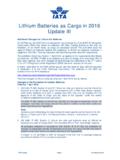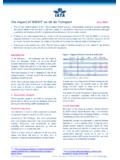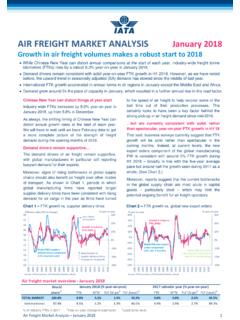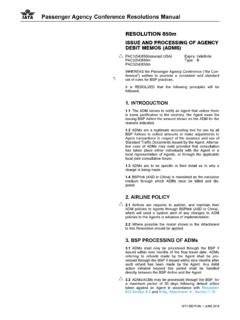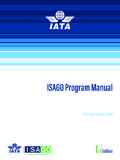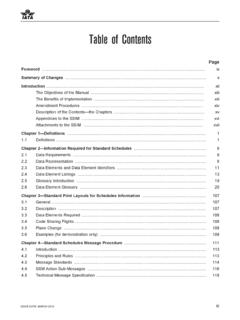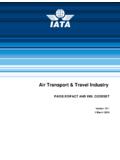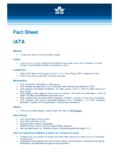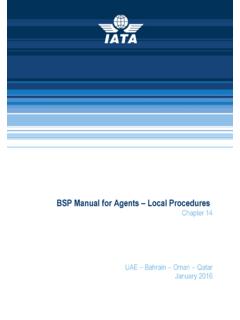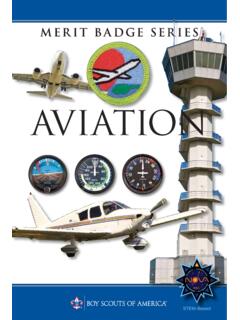Transcription of IATA Fact Sheet
1 May 2019 Sustainable aviation Fuels Fact Sheet Sustainable aviation Fuels (SAF) are being produced and used in commercial flights every day. Current volumes produced are low (<1% of total jet fuel demand), however, these volumes can be substantially increased with coordinated support including effective policy frameworks. New production is expected to come online during 2020, which should see a 3-4 fold increase in SAF available in 2020, relative to 2019. Contrary to the ground transport sector, which can use electric energy, aviation has no near-term alternative to liquid hydrocarbon fuels (electric commercial aircraft are unlikely before 2040). In the medium term, SAF will be the only energy solution to mitigate the emissions growth of the industry. SAF will be an eligible option for aircraft operators to meet their obligations under the Carbon Offsetting and Reduction Scheme for International aviation (CORSIA).
2 IATA supports research, development and deployment of SAF that meet environmental, societal and economic sustainability criteria. IATA follows sustainability developments closely and is a member of the ISCC and the Roundtable on Sustainable Biomaterials (RSB). RSB has developed the most comprehensive sustainability standards for biofuels. At the 73rd IATA AGM in Cancun, 2017, IATA members unanimously agreed a resolution on the deployment of SAF, including calling for constructive government policies, and committing to only use fuels which conserve ecological balance and avoid depletion of natural resources. IATA believes that if all options to increase SAF production are explored, up to 1 billion passengers can have flown on a SAF-blend flight by 2025 and with appropriate policy support, penetration should be approaching 2% (circa 7 billion litres). Lifecycle greenhouse gas emissions from SAF can be at least 80% lower than traditional jet fuel.
3 Like conventional jet fuel, SAF requires a strict technical certification addressing that SAF: Can be safely mixed with conventional jet fuel, can use the same supply infrastructure and does not require adaptation of aircraft or engines Meets the equivalent or higher technical specifications as conventional jet fuel 5 technical production pathways have been certified under ASTM d7566 Certification work continues and more are expected in the next 18 months Sustainable aviation Fuels in Practice Main milestones so far: 2008 The first test flight with biojet fuel was performed by Virgin Atlantic. Between 2011 and 2015 22 airlines performed over 2,500 commercial passenger flights with blends of up to 50% biojet fuel from feedstock including used cooking oil, jatropha, camelina, algae and sugarcane. January 2016 Regular sustainable fuel supply through the common hydrant system started at Oslo Airport.
4 Alternative fuel producer Neste and supplier SkyNRG as well as Air BP are involved. March 2016 United became the first airline to introduce SAF into normal business operations by commencing daily flights from Los Angeles Airport (LAX), supplied by AltAir. May 2019 December 2019 More than 215,000 commercial flights using SAF have been performed, 40 airlines with SAF experience and 6 billion litres in forward purchase agreements. Several airlines have concluded long-term offtake agreements with biofuel suppliers, many of which are reported as commercially competitive. A number of airports have agreed to supply SAF through their hydrant system. IATA s Strategic Action Plan Industry actions Developed an industry roadmap (2015) highlighting best practice for technology adoption, policy and regulation, economics, sustainability and accounting standards Provide industry leadership and publicly available guidance material on best practice concerning.
5 Sustainability standards, accounting procedures, logistics, communication, effective policy and business case development Influence policy negotiations to ensure aviation can opt in to existing ground transport policies and in some cases have aviation preferentially incentivized to use SAF Role of governments Adopt globally-recognized sustainability standards and work to harmonize global standards Ensure existing policy incentive frameworks designed for ground transport, also include aviation and apply higher incentives for aviation over ground transport which has other energy alternatives. Encourage user-friendly sustainable aviation fuel accounting methods and work to harmonize global standards Support sustainable aviation fuel R&D and demonstration plants Implement policies that de-risk investments into sustainable aviation fuel production plants Engage in public-private partnerships for sustainable aviation fuel production and supply Commit to policy certainty or at a minimum policy timeframe that match investment timeframes Challenges and opportunities both political and commercial Due to issues of scale and yet to be optimized processes, a number of SAF production pathways are more expensive than fossil Jet A/A1, especially at small scale.
6 In the United States, a combination of incentives such as the Renewable Fuel Standard (RFS) and Low Carbon Fuel Standard in California, support for building up new-technology production plants and incentives for agriculture, can enable price-competitive SAF off-take agreements. In Europe, from 2020 the Renewable Energy Directive (II) (2020-2030) will apply a multiplier ( ) for producers making SAF rather than ground transport fuel. This policy has the potential to increase the production of SAF, especially if Member States layer this initiative with domestic support policies Some countries are considering country-wide plans for ending the use of fossil fuels. This implies material strategic considerations for aviation . The effectiveness of different policy mechanisms for commercially deploying sustainable aviation fuel has been assessed by the ICAO Alternative Fuel Task Force during the CAEP/11 cycle ( 2016 -2019).
7 Additional policy analysis will occur, led by IATA and the FAA during the CAEP/12 cycle (2019-2022).
